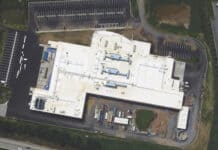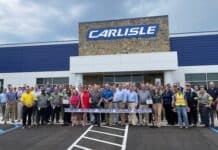By Kevin Blische
Roofing work on historic structures always comes with distinct challenges. Cram Roofing, based in San Antonio, TX, recently had the honor of contributing to the Alamo in downtown San Antonio by way of re-roofing a major building on the Alamo grounds, the 5,500 square foot Long Barrack. Built in the 1700s, the Long Barrack provided housing to the Alamo’s defenders during the famous siege 180 years ago. The building had also served as the first hospital in Texas in the early 1800s and as a convent decades earlier.
The basics sound like a fairly routine commercial roof project: removal of the old roof, replacing old beams, and installing a new SBS-modified bitumen roof.

But that’s only part of the story. As we’ve learned working on other historic sites (Kennedy Space Center, Fort Sam Houston, Camp Lejeune, and others), at least three major aspects of roofing work on historic structures separate these projects from work sites that are not major historic landmarks.
1. Working on historic structures means maintaining the historic appearance. This seems obvious but it can be quite tricky. Modern materials and technologies don’t look like the ones used decades or hundreds of years ago. Blending the new with the old requires creativity and flexibility.
At the Alamo, for example, the surface where flashing was needed was uneven and wavy. That aesthetic had to be preserved, so a squared-off, metallic flashing approach was out of the question. Our team used PMMA liquid-applied flashing to overcome this challenge.
Well into the project, the client also informed us that the traditional white color of the PMMA flashing was unacceptable. A few phone calls and emailed photos later, our flashing supplier was able to custom mix the material into a color that matched the original quite well. Historic appearance: preserved.
2. Communication is even more critical on historic projects. Historic buildings like the Alamo and many more around the U.S. often also are major tourism sites. The Alamo hosts more than 2.5 million visitors annually. It also serves as a shrine to those who died defending it. In short, the Alamo is hallowed grounds.
That means a very long list of stakeholders wanted to be kept informed, sometimes in great detail, as the project progressed. From the governor of Texas to the park rangers, frequent updates were the order of the day. All of the contractors working on various pieces of the Long Barrack project met weekly to ensure both internal and external communications were complete and accurate at any given moment.

3. Scheduling takes on special importance. With something like 7,000 visitors on an average day, the Alamo is a high-traffic work site, to say the least. Managed by an office of the State of Texas, facility management did not want Alamo visitors contending with contractors moving materials and equipment into the Alamo grounds when the site was open the public. So, everything needed for the day’s work had to be loaded in before the public was allowed access starting at 9 a.m. daily.
That also meant all contractors had to wait until after the Alamo closed to visitors at 5:30 p.m. daily to remove anything from their work areas for the night. Team leaders had to be especially diligent and thorough in planning each day’s workflow, materials and equipment needs to meet this important requirement.
In summary, historic structure roofing demands the ability to solve difficult problems that are often unique to the given building. And solving problems that weren’t known before the work started. Creativity, a can-do attitude and know-how are the keys to making it work.
Blische is estimating sales manager at Cram Roofing, a full-service commercial and governmental roofing contractor in San Antonio, TX that offers a vast range of engineered roofing solutions.


















![[VIDEO] Collect Asset Data at the Speed of Walking a Building](https://facilityexecutive.com/wp-content/uploads/2024/02/maxresdefault-324x160.jpg)